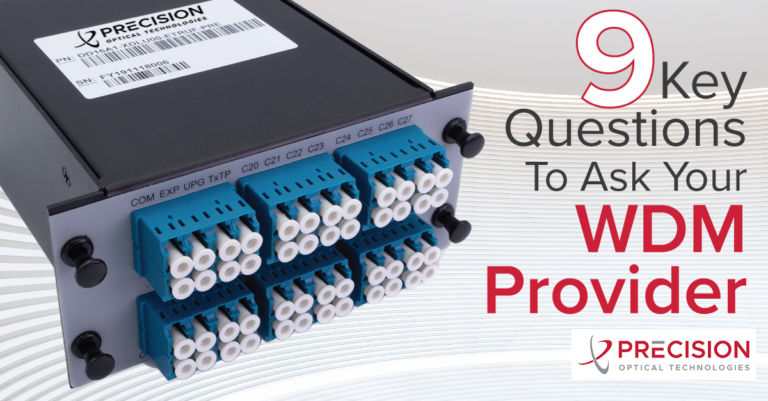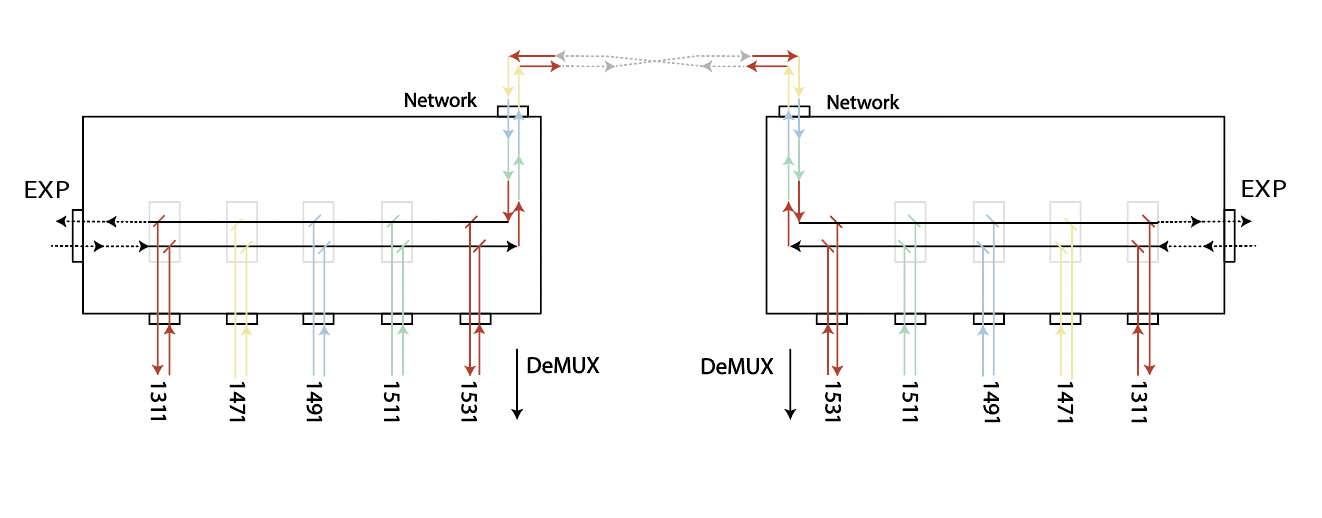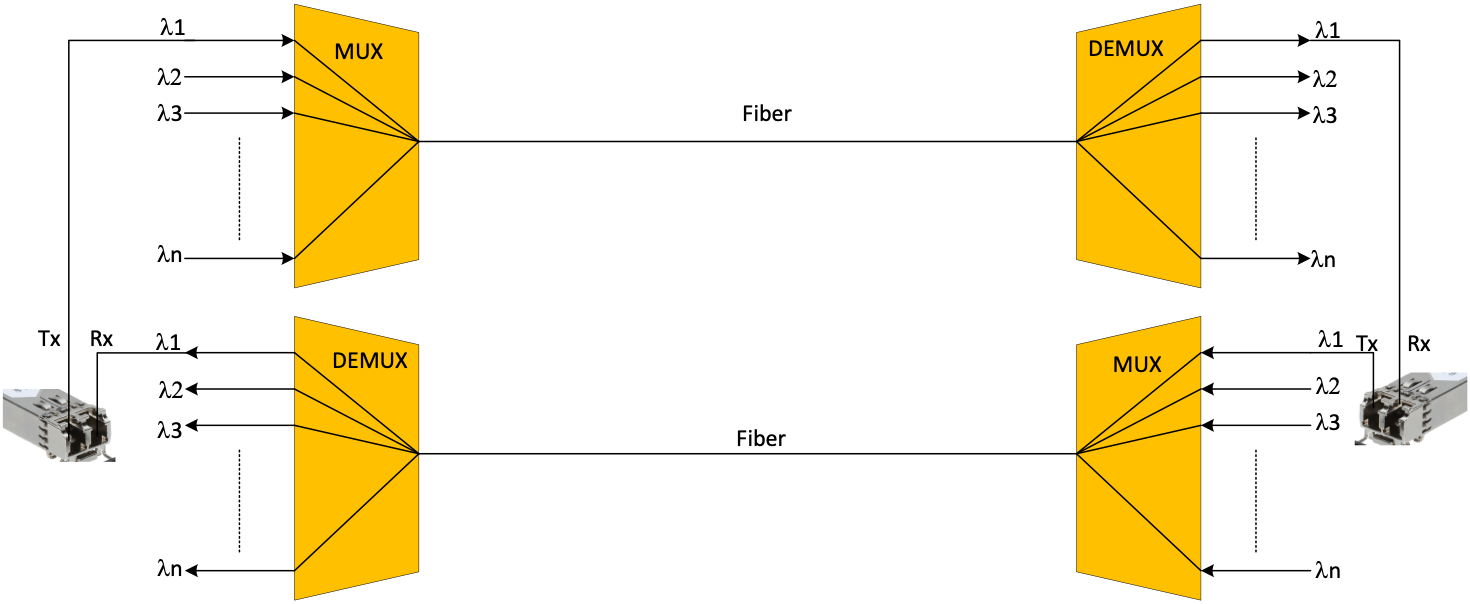
Passive Mux/Demux: 9 Questions to Ask About WDM

In planning out your CWDM and/or DWDM network, there are 9 questions to consider and discuss with your passives partner:
Passive (unpowered) networking components provide an efficient, reliable method of maximizing bandwidth while using minimal fiber. Historically, passive technologies such as wavelength-division multiplexing (WDM) were used for long-haul and subsea transmission. In more recent years, WDM has worked its way out to the edge and passive optical networks (PONs) utilizing WDM have become the primary way of enabling fiber-to-the-home and other user endpoints (FTTX). According to Strategy Analytics, multiple factors stemming from increases in work/learn from home requirements to the need to replace aging copper networks are resulting in a “boom in new FTTH deployments. These will peak in 2024-26 and continue throughout the decade.” Modern telecommunications networks may include range of passive devices and storage solutions including filters, optical splitters, add/drop modules, MPO/MTP breakout panels, rack/wall mount solutions and more.
Passive CWDM and DWDM Solutions
Mux/Demux (Multiplexing/Demultiplexing) devices use wavelength combining/dividing filters to Mux(combine) or Demux(separate) optical signals such that they can be transmitted on a single fiber (without interfering with each other) thus increasing the capacity of that one fiber. 
WDM can be further categorized as Coarse WDM (1271nm to 1611nm) and Dense WDM (C-band). What are the advantages of deploying CWDM and DWDM networks?
- It’s a simple method for operating multiple waves on single fibers
- Passive hardware is lower cost than active
- Fiber is very expensive to lease or construct
- Bandwidth demands have increased
- WDM can maximize the use of leased or depleted fiber
- Passive systems are low in complexity
- Have no or few active components & are highly reliable
- Typical plug & play with no provisioning
- Protocol transparent transport method
- Not powered, will function in remote and/or unpowered locations
MUX/DEMUX applications can be found throughout various levels of a telecommunications network from Long Haul to Access.
Designing and Deploying Passive Mux/Demux
In planning out your CWDM and/or DWDM network, there are 9 questions to consider and discuss with your passives partner:
1. Which application do I need? CWDM or DWDM?
Do you have/plan to install CWDM or DWDM? Some things to consider are how many channels you need now and how many you might need in the future. CWDMs offer 18 channels from 1271nm to 1611nm. DWDMs can offer well over 40 channels, even up to 96 channels.
2. Will my MUX/DEMUX be used indoors or outdoors?
Once the type of WDM is determined, next think about where the MUX/DEMUX will be installed; inside plant (ISP) or outside plant (OSP)? CWDM and DWDM filters are available in field-deployable standalone modules and tray-mounted enclosures with mounting chassis options.
3. Do I need a single fiber or dual fiber application?
You will then want to consider the fiber type, Single or Dual? Because these filters are bi-directional, they can be used as a Mux or a Demux…or BOTH!
Fig. 2a Single Fiber Mux / DeMux Configuration
Fig. 2b Dual Fiber Mux / DeMux Configuration
If you are limited to a single fiber, a Single module such as the ISP example products shown in Table 1, can Mux any number of channels on one end and Demux them at the other end with another Single module. Or perhaps you want to Mux half of your channels in one direction and Demux half of them in the other. The same setup will do this with Single modules. Maybe you have two fibers to work with. Using a Twin module, you can multiplex all your channels onto one fiber and Demux all of the channels coming in on another fiber as shown in Fig. 2b.
Table 1 Examples of ISP CWDM Passive Filter products, Single LGX Form Factor
4. Which channels will I utilize?
CWDMs commonly use the “upper 8” channels (1471-1611nm) but can expand to 18 total channels (1271-1611nm, spaced 20nm apart). DWDMs are generally offered in 3 different channel spacings (50GHz, 100GHz, 200GHz). 100GHz has become the most used spacing and the DWDM ITU grid defines the specific center wavelength and its corresponding channel number. Much of the industry focus is between channels 14 and 62.
5. Where are these going?
What type of housing or enclosure will these components be in? For ISP applications; LGX module? Rack mounted? Wall mounted? For OSP applications; Cassette size? What outdoor enclosure does this need to fit in?
6. Which connectors will I need?
What type of connectors will you need? LC and SC have become a common choice, but will you want angled or straight polish?
7. Are any additional ports needed?
Note that aside from the channel ports, additional ports are available with several uses. Test ports allow you to monitor what is being received and transmitted on the Common ports of your module. Express ports provide further expansion of CWDM channels or integration of other wavelengths used in the 1260-1520 & 1570-1635nm range. Upgrade ports allow you to expand on your existing DWDM network or expand into using DWDMs from your CWDM network. Perhaps you need to integrate something in the 1260-1360nm range with your CWDM or DWDM network. A 1310 wideband port can provide for this.
Fig. 3 MUX/DEMUX Port Examples
8. What pigtail length do I need for my application?
Once you have a good idea of the cassette size you will need for OSP, you will have to determine the pigtail length needed.
9. What jacket thickness do I need for my application?
Along with the pigtail length, you will want to decide on a jacket thickness. Factors like location, space, durability, and handling will all help determine whether a bare fiber or a more robust fiber jacketing is warranted.
Conclusion
MSO networks are using passive Mux/Demux systems to scale network capacity with exponential growth. Whatever passive CWDM and DWDM needs you may have for your network, Precision Optical Technologies has an array of product options and systems expertise to guide you. For solutions designed to work within your infrastructure and ensure flexibility to expand in the future, contact the experts at Precision Optical Technologies!










